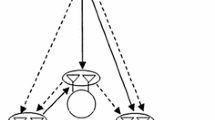Abstract
Cognitive radio is a novel approach to cope with spectrum scarcity, in which either a network or a wireless node changes its transmission or reception parameters to communicate efficiently. However, it is difficult to avoid the interference between licensed and unlicensed users in various scenarios. This paper analyzes the jointly optimized allocation of sensing time and power for a two-user, amplify-and-forward (AF) cognitive network developed by maximizing the average aggregate throughput of its secondary network. In particular, this paper discusses diverse cooperation ratios for different scenarios and a unique cooperation ratio in spite of scenario changes. The observations of experiment results indicate that the sensing duration is within a strict interval. The results show that the optimized sensing time is 14.111 ms and the aggregate throughput equals to 1.1451 bps/Hz which are tractable by sequential optimization. This result indicates that by adopting the fixed cooperation ratios, the achievable throughput of the system is decreased. The system innovatively creates multiple independent fading channels to achieve technological diversity among partners.






Similar content being viewed by others
References
Sendonaris A, Erkip E, Aazhang B (Nov. 2003) User cooperation diversity-part i: system description. IEEE Trans Commun 51(11):1927–1938. https://doi.org/10.1109/TCOMM.2003.818096
Sharma SK, Bogale TE, Chatzinotas S, Ottersten B, Le LB, Wang XB (2015) Cognitive radio techniques under practical imperfections: a survey. IEEE Commun Surv Tutorials 17(4):1858–1884. https://doi.org/10.1109/COMST.2015.2452414
Liang Y, Zeng Y, Peh E, Hoang A (Apr. 2008) Sensing-throughput tradeoff for cognitive radio networks. IEEE Trans Wirel Commun 7(4):1326–1337. https://doi.org/10.1109/TWC.2008.060869
Hoang AT, Liang Y, Wong D, Zeng Y, Zhang R (Mar. 2009) Opportunistic spectrum access for energy-constrained cognitive radios. IEEE Trans Wirel Commun 8(3):1206–1211. https://doi.org/10.1109/TWC.2009.080763
Quan Z, Cui S, Sayed A, Poor H (Mar. 2009) Optimized multiband joint detection for spectrum sensing in cognitive radio networks. IEEE Trans Signal Process 57(3):1128–1140. https://doi.org/10.1109/TSP.2008.2008540
Pei Y, Liang Y, Teh K, Li K (Nov. 2009) How much time is needed for wideband spectrum sensing. IEEE Trans Wirel Commun 8(11):5466–5471. https://doi.org/10.1109/TWC.2009.090350
Laneman J, Tse D, Wornell G (Dec. 2004) Cooperative diversity in wireless networks: efficient protocols and outage behavior. IEEE Trans Inf Theory 50(12):3062–3080. https://doi.org/10.1109/TIT.2004.838089
Deng X, Haimovich A (Nov. 2005) Power allocation for cooperative relaying in wireless networks. IEEE Commun Lett 9(11):994–996. https://doi.org/10.1109/LCOMM.2005.11012
Yu H, Tang W, Li S (2014) Joint optimized sensing time and power allocation for multi-channel cognitive radio networks considering sensing-channel selection. SCIENCE CHINA Inf Sci 57:1–8
Zhang H, Nie Y, Cheng J, Leung VCM, Nallanathan A (2017) Sensing time optimization and power control for energy efficient cognitive small cell with imperfect hybrid spectrum sensing. IEEE Trans Wirel Commun 16(2):730–743. https://doi.org/10.1109/TWC.2016.2628821
Wong VWS, Schober R, Ng DWK, Wang L-C (2017) Key technologies for 5G wireless systems. Cambridge University Press. https://doi.org/10.1017/9781316771655
Zhao C, Kwak K (2010) Joint sensing time and power allocation in cooperatively cognitive networks. IEEE Commun Lett 14(2):163–165. https://doi.org/10.1109/LCOMM.2010.02.092102
Zhao L, Liao Z (Jul. 2008) Power allocation for amplify-and-forward cooperative transmission over Rayleigh-fading channels. J Commun 3(3):33–42
Mesbah W, Davidson T (Nov. 2008) Joint power and channel resource allocation for two-user orthogonal amplify-and-forward cooperation. IEEE Trans Wirel Commun 7(11):4681–4691. https://doi.org/10.1109/T-WC.2008.070748
Acknowledgements
This research was supported by the Education Department of Shaanxi Province (17JZ047, 17JK0425); the Special Foundation for Young Scientists of Xi’an University of Architecture and Technology (6040516148); and the Talent Technology Foundation of Xi’an University of Architecture and Technology (6040300613).
Author information
Authors and Affiliations
Corresponding author
Appendix 1: Proof of R(β1, l, β2, l) as a concave function
Appendix 1: Proof of R(β1, l, β2, l) as a concave function
The proof starts with the characteristics of a concave function. If the function R(β1, l, β2, l) is a second order derivative in a certain interval, the necessary and sufficient condition for this function to be a concave function is that \( \frac{\partial^2R\left({\beta}_i\right)}{\partial^2{\beta}_1}<0 \) and \( \frac{\partial^2R\left({\beta}_i\right)}{\partial^2{\beta}_2}<0 \).Therefore, it is necessary to prove that the second derivative of \( \frac{\partial^2\mathrm{R}\left({\upbeta}_{\mathrm{i}}\right)}{\partial^2{\upbeta}_1}<0 \) and \( \frac{\partial^2\mathrm{R}\left({\upbeta}_{\mathrm{i}}\right)}{\partial^2{\upbeta}_2}<0 \). The following steps are to prove \( \frac{\partial^2R\left({\beta}_i\right)}{\partial^2{\beta}_1}<0 \). The same explanation is applicable to the proof of \( \frac{\partial^2\mathrm{R}\left({\upbeta}_{\mathrm{i}}\right)}{\partial^2{\upbeta}_2}<0 \).
-
(1)
Calculate the first derivative:
where:
-
(2)
Calculate the second derivative:
where:
So we know that,
And we can say that,
From the process we know that \( \frac{\partial^2R\left({\beta}_i\right)}{\partial^2{\beta}_1} \)<0. Similarly, it is easy to prove that \( \frac{\partial^2R\left({\beta}_i\right)}{\partial^2{\beta}_2} \)<0. In conclusion, we knew that R(β1, l, β2, l) is a concave function.
Rights and permissions
About this article
Cite this article
Ruan, S., Zhao, C., Jiang, S. et al. Joint sensing time and power allocation in cognitive networks with amplify-and-forward cooperation. Ann. Telecommun. 73, 391–399 (2018). https://doi.org/10.1007/s12243-018-0625-8
Received:
Accepted:
Published:
Issue Date:
DOI: https://doi.org/10.1007/s12243-018-0625-8




